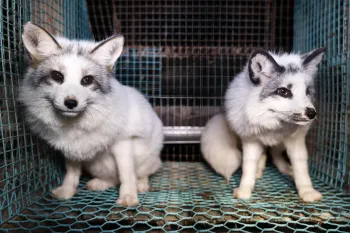BRUSSELS - Animal protection groups have renewed their call on the European Commission to bring forward an EU-wide ban on fur farming and trade as they launched a new economic report in Parliament today showing that fur farming is so financially unviable it costs the EU millions of euros annually.
The report, A full-cost account of the EU fur industry, was authored by environmental economist Griffin Carpenter. It sheds light on the fragile economic state of the fur industry and demonstrates that the environmental costs and public health costs attributed to the EU fur farming sector far exceeds its gross value added (GVA). The total economic burden to EU citizens, calculated by deducting those costs from gross value added, comes €446 million a year.
EU fur farming has been unprofitable for several years as pelt prices have fallen below production costs. As the value of pelts has plummeted, by 92% in sales value in the last decade, the industry is no longer financially viable. Generating a loss of €9.2million in GVA, the industry reduces, rather than contributes, to the EU economy.
Fur production also comes at a significant environmental cost, estimated at €226 million annually, in harms from pollution, resource use, local disamenity, and issues arising from escapes of non-native species. The industry’s heavy emissions have been linked to chronic respiratory diseases and premature deaths across Europe.
Fur farms present a huge public health threat, posing as high-risk reservoirs for zoonotic diseases, a case made highly evident during the COVID-19 pandemic. The report estimates that measures to prevent the transmission of zoonotic pathogens would cost up to €211 million annually.
All this comes at an ultimate cost of the lives of millions of fur-bearing animals, who are confined to cages enduring psychological distress, hindered from displaying natural behaviour and suffering physical injuries, all for an unnecessary fashion product that citizens and major brands are turning away from.
This report, launched at the European Parliament today, comes weeks after the European Food Safety Authority, in its scientific opinion to the European Commission, made it clear that animal suffering is unavoidable on fur farms and the needs of animals cannot be met, irrespective of further enrichment. This opinion was commissioned in response to the Fur Free Europe European Citizens’ Initiative, supported by 1.5 million EU citizens. The Commission is expected to provide a final response by March 2026.
“The fur sector’s apparent profits mask staggering hidden costs - on public health, biodiversity, animal welfare, and the climate. This new study gives us even stronger grounds to demand legislation that ensures no trade is allowed to benefit from cruelty and ecological damage within the single market,” commented MEP Kristian Vigenin (S&D), who hosted the event at the European Parliament.
Griffin Carpenter, the report’s author, stated: “Typically in these exercises we test to see if an industry adds more economic value to society than it subtracts in environmental or social costs. The fur industry is the first time I’ve seen an industry that is starting from a position of negative economic value. Incorporating environmental and public health costs makes this negative societal contribution even worse.
“EU fur farming has been unprofitable for several years and the sector is no longer financially viable without other sources of funds. The industry is also a major recipient of public funds which, on balance, greatly exceed tax revenues.”
Dr Joanna Swabe, senior director of public affairs at Humane World for Animals Europe, formerly known as Humane Society International, said: “This report very clearly shows that the fur industry is in great financial decline. Moreover, the damage caused by fur farming, from environmental degradation and public health risk, not to mention the suffering and death of millions of sentient animals each year, far outweighs any benefit it could ever have to our society.
“EFSA's recent scientific opinion has shown that animals' complex welfare needs are not being met on fur farms, and this report shows that the industry is not financially viable. The European Commission needs to act decisively to shut this cruel and failing industry down for good.”
Key findings from the report include:
- Twenty-three EU Member States have taken action through full, partial or effective bans. The main countries that allow the practice to continue are Poland, Finland and Greece.
- EU fur farming has seen a dramatic decline, mirroring a global downturn. The number of animals killed and pelted for their fur has declined by 86% in the last decade, to 6.3 million animals in 2024. The value of fur pelt sales has declined by 92% in the same period, to an estimated €183 million in 2024. As existing phase-out periods come to an end by 2028, production is expected to decline by a further 15-20%.
- The fur industry makes up less than 0.003% of EU jobs. In the last decade, the number of EU fur farms has fallen by 73% and farm employment is estimated to have fallen by between 86-92% in the same period.
- EU fur farming is a major recipient of public funds in the form of compensation for lost sales (e.g. due to Covid-19, avian influenza, sanctions on Russian trade). On balance these payments greatly exceed tax revenues.
ENDS
Notes:
- Report: A full-cost account of the EU fur industry
- Authored by Griffin Carpenter.
- Contributors Eurogroup for Animals, Fur Free Alliance, FOUR PAWS, Humane World for Animals.
